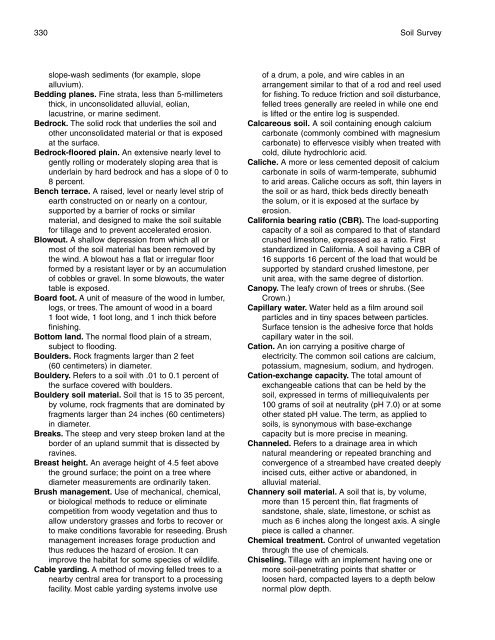Soil Survey of Sweet Grass County Area, Montana - Soil Data Mart
Soil Survey of Sweet Grass County Area, Montana - Soil Data Mart
Soil Survey of Sweet Grass County Area, Montana - Soil Data Mart
You also want an ePaper? Increase the reach of your titles
YUMPU automatically turns print PDFs into web optimized ePapers that Google loves.
330 <strong>Soil</strong> <strong>Survey</strong><br />
slope-wash sediments (for example, slope<br />
alluvium).<br />
Bedding planes. Fine strata, less than 5-millimeters<br />
thick, in unconsolidated alluvial, eolian,<br />
lacustrine, or marine sediment.<br />
Bedrock. The solid rock that underlies the soil and<br />
other unconsolidated material or that is exposed<br />
at the surface.<br />
Bedrock-floored plain. An extensive nearly level to<br />
gently rolling or moderately sloping area that is<br />
underlain by hard bedrock and has a slope <strong>of</strong> 0 to<br />
8 percent.<br />
Bench terrace. A raised, level or nearly level strip <strong>of</strong><br />
earth constructed on or nearly on a contour,<br />
supported by a barrier <strong>of</strong> rocks or similar<br />
material, and designed to make the soil suitable<br />
for tillage and to prevent accelerated erosion.<br />
Blowout. A shallow depression from which all or<br />
most <strong>of</strong> the soil material has been removed by<br />
the wind. A blowout has a flat or irregular floor<br />
formed by a resistant layer or by an accumulation<br />
<strong>of</strong> cobbles or gravel. In some blowouts, the water<br />
table is exposed.<br />
Board foot. A unit <strong>of</strong> measure <strong>of</strong> the wood in lumber,<br />
logs, or trees. The amount <strong>of</strong> wood in a board<br />
1 foot wide, 1 foot long, and 1 inch thick before<br />
finishing.<br />
Bottom land. The normal flood plain <strong>of</strong> a stream,<br />
subject to flooding.<br />
Boulders. Rock fragments larger than 2 feet<br />
(60 centimeters) in diameter.<br />
Bouldery. Refers to a soil with .01 to 0.1 percent <strong>of</strong><br />
the surface covered with boulders.<br />
Bouldery soil material. <strong>Soil</strong> that is 15 to 35 percent,<br />
by volume, rock fragments that are dominated by<br />
fragments larger than 24 inches (60 centimeters)<br />
in diameter.<br />
Breaks. The steep and very steep broken land at the<br />
border <strong>of</strong> an upland summit that is dissected by<br />
ravines.<br />
Breast height. An average height <strong>of</strong> 4.5 feet above<br />
the ground surface; the point on a tree where<br />
diameter measurements are ordinarily taken.<br />
Brush management. Use <strong>of</strong> mechanical, chemical,<br />
or biological methods to reduce or eliminate<br />
competition from woody vegetation and thus to<br />
allow understory grasses and forbs to recover or<br />
to make conditions favorable for reseeding. Brush<br />
management increases forage production and<br />
thus reduces the hazard <strong>of</strong> erosion. It can<br />
improve the habitat for some species <strong>of</strong> wildlife.<br />
Cable yarding. A method <strong>of</strong> moving felled trees to a<br />
nearby central area for transport to a processing<br />
facility. Most cable yarding systems involve use<br />
<strong>of</strong> a drum, a pole, and wire cables in an<br />
arrangement similar to that <strong>of</strong> a rod and reel used<br />
for fishing. To reduce friction and soil disturbance,<br />
felled trees generally are reeled in while one end<br />
is lifted or the entire log is suspended.<br />
Calcareous soil. A soil containing enough calcium<br />
carbonate (commonly combined with magnesium<br />
carbonate) to effervesce visibly when treated with<br />
cold, dilute hydrochloric acid.<br />
Caliche. A more or less cemented deposit <strong>of</strong> calcium<br />
carbonate in soils <strong>of</strong> warm-temperate, subhumid<br />
to arid areas. Caliche occurs as s<strong>of</strong>t, thin layers in<br />
the soil or as hard, thick beds directly beneath<br />
the solum, or it is exposed at the surface by<br />
erosion.<br />
California bearing ratio (CBR). The load-supporting<br />
capacity <strong>of</strong> a soil as compared to that <strong>of</strong> standard<br />
crushed limestone, expressed as a ratio. First<br />
standardized in California. A soil having a CBR <strong>of</strong><br />
16 supports 16 percent <strong>of</strong> the load that would be<br />
supported by standard crushed limestone, per<br />
unit area, with the same degree <strong>of</strong> distortion.<br />
Canopy. The leafy crown <strong>of</strong> trees or shrubs. (See<br />
Crown.)<br />
Capillary water. Water held as a film around soil<br />
particles and in tiny spaces between particles.<br />
Surface tension is the adhesive force that holds<br />
capillary water in the soil.<br />
Cation. An ion carrying a positive charge <strong>of</strong><br />
electricity. The common soil cations are calcium,<br />
potassium, magnesium, sodium, and hydrogen.<br />
Cation-exchange capacity. The total amount <strong>of</strong><br />
exchangeable cations that can be held by the<br />
soil, expressed in terms <strong>of</strong> milliequivalents per<br />
100 grams <strong>of</strong> soil at neutrality (pH 7.0) or at some<br />
other stated pH value. The term, as applied to<br />
soils, is synonymous with base-exchange<br />
capacity but is more precise in meaning.<br />
Channeled. Refers to a drainage area in which<br />
natural meandering or repeated branching and<br />
convergence <strong>of</strong> a streambed have created deeply<br />
incised cuts, either active or abandoned, in<br />
alluvial material.<br />
Channery soil material. A soil that is, by volume,<br />
more than 15 percent thin, flat fragments <strong>of</strong><br />
sandstone, shale, slate, limestone, or schist as<br />
much as 6 inches along the longest axis. A single<br />
piece is called a channer.<br />
Chemical treatment. Control <strong>of</strong> unwanted vegetation<br />
through the use <strong>of</strong> chemicals.<br />
Chiseling. Tillage with an implement having one or<br />
more soil-penetrating points that shatter or<br />
loosen hard, compacted layers to a depth below<br />
normal plow depth.
















